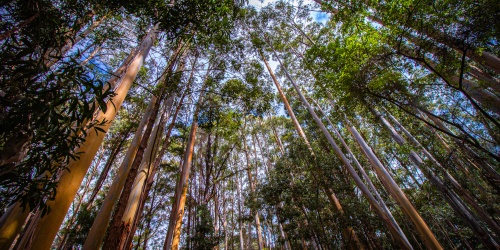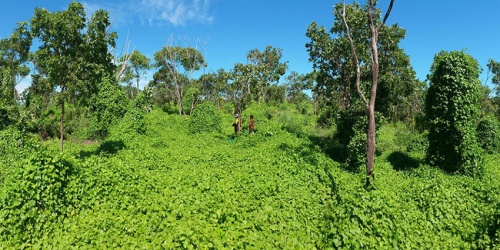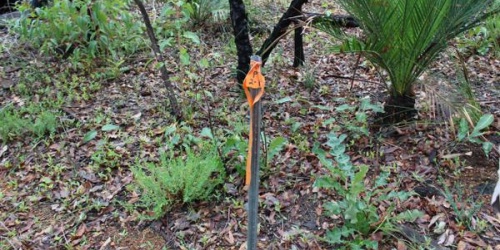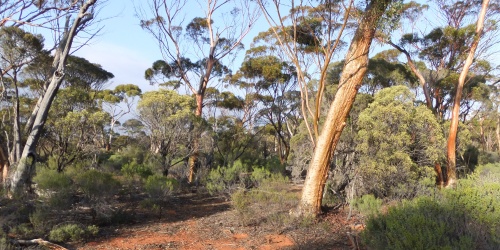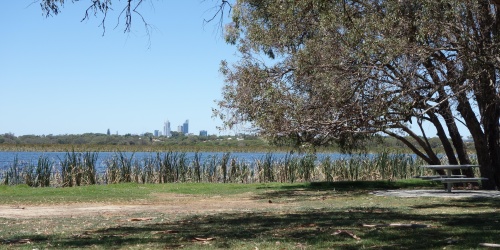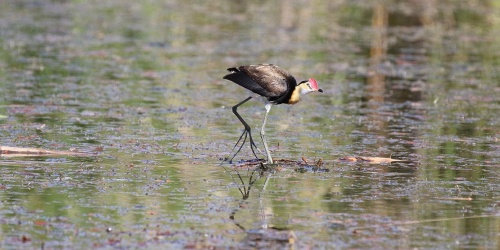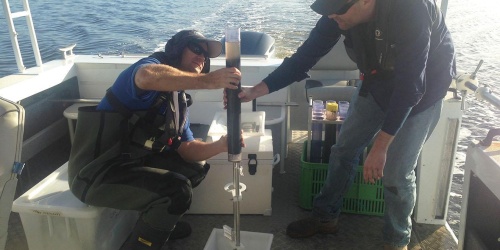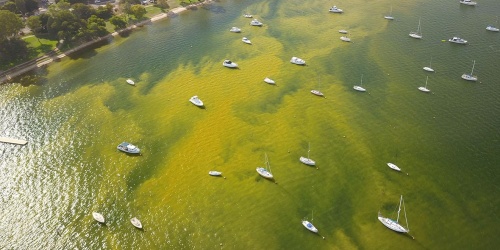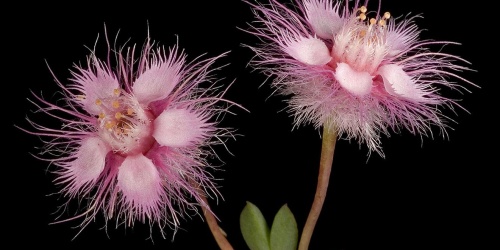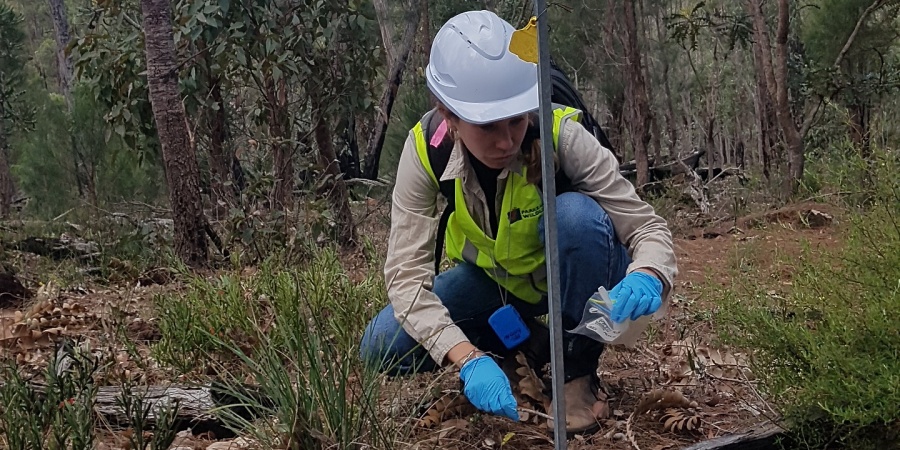
A DBCA scientist conducting research in a forest
Program
Ecosystem Science
Project status
Completed
About the research project
FORESTCHECK was an integrated monitoring program designed to assess the responses of biodiversity and habitat structure to timber harvesting in the Jarrah Forest. Unlike many ecological monitoring programs which have focussed on particular species or groups and smaller areas, the intent of FORESTCHECK is to focus on a wide range of biodiversity, across the breadth of the Jarrah Forest, to be able to make robust assessments of responses to harvesting at a regional scale.
The project undertook two rounds of sampling at each of 63 sites (‘grids’) spread across six Jarrah ecosystems between 2001 and 2020. Each site was allocated to one of three treatments: Shelterwood/Selective Cut harvesting or Gap Release harvesting, plus reference sites which had never been harvested or which had not been harvested in the previous 40 years. The harvesting regimes examined were those used most widely in the Jarrah Forest.
Shelterwood harvesting is the partial removal of trees (average removal of 30% of overstorey basal area) to encourage seedlings to establish and develop within the forest stand. Sufficient overstorey is retained to provide a seed source and maintain forest values while seedlings develop. This practice has been used where trees were ready to be felled but there was an inadequate number of saplings to take their place. Selective cut refers to the practice of removing an even smaller proportion of trees where few trees in a coupe are commercially valuable.
Gap release harvesting is the removal of larger proportions of the understorey (70% of overstorey basal area on average) to allow saplings to develop without obstruction, and to eventually become a new forest. It was used when there was an adequate supply of saplings.
Reference grids were in areas such as national parks, conservation reserves, fauna habitat zones and coupe buffer zones.
Elements sampled for the first 48 sites, sampled in 2001-2005 and 2006-2011, included fungi, cryptogams, flora, ground-dwelling invertebrates, birds and ground-dwelling reptiles, amphibians and mammals, plus measurements of the physical attributes of forests, leaf litter, coarse woody debris, soil nutrients and degree of soil disturbance and compaction. A subset of these elements was sampled at sites 49 to 63 between 2013 and 2020. The image below shows the spatial arrangement of the sampling locations for each sampled element, with the same layout used at all grids for consistency. Further details of the sampling program are presented in the papers listed below, along with results of the two rounds of monitoring.
Additional sampling, with a subset of the biological groups sampled, was also undertaken in the northern Jarrah Forest to examine differences in biodiversity across sites with differing times since fire.
The project is now closed, with this research and monitoring focus now covered by the Forest Health Monitoring Program.
Management outcomes
FORESTCHECK has provided a greatly improved understanding of the biodiversity supported by Jarrah forests and how this is distributed. A total of 3787 taxa were recorded across the six biological groups over the two rounds of monitoring at the first 48 sites. Richest groups were invertebrates (59 % of species) followed by macrofungi (17 %), vascular plants (13 %) and lichens (7 %). There were significant differences in the types of species occurring across the five jarrah forest ecosystems.
Analyses have shown minimal impact of the two harvesting techniques on the biodiversity elements studied. Of the taxa recorded in the first 48 grids, 17 % were only present in reference forest and 28 % only in harvested forest, although this would partly reflect the fact that there were more harvested sites (29) than unharvested sites (19).
There was little to no effect of harvesting technique on the mean richness of invertebrates, macrofungi, vascular plants, or birds for either monitoring round in the first 48 sites. However, the mean per grid richness of cryptogams and terrestrial vertebrates differed significantly between treatments. In the first monitoring round, the number of species of cryptogams was higher in reference grids than in either type of harvested grid. In the second round, richness in reference grids was much lower than during the first monitoring round but this decline did not occur in the harvested grids, so that reference and harvested grids had similar cryptogam richness in round 2. For terrestrial ground-dwelling vertebrates, the number of species in reference sites was lower than that in the gap release treatment in the first monitoring round and lower than shelterwood treatment in both monitoring rounds. However, this is confounded by there being greater control of foxes in the harvested sites.
Harvesting had no effect on the composition of terrestrial vertebrates, flora, invertebrates and fungal communities. The composition of bird communities differed between reference and gap release sites in the first and second round of sampling. The composition of cryptogam communities differed between the reference sites and both types of harvested sites in the first monitoring round, but for the second round there were only differences between reference sites and gap release sites.
Similar results were obtained in later analyses of an additional 16 sites within two jarrah ecosystems, with little effect of harvesting on species richness other than a small and inconsistent effect on vascular plants. Overall biological composition didn’t respond to harvesting except for a small effect when both harvesting types together were compared to non-harvesting, and this was largely an effect on fungi.
Progress
Analyses of the biological responses to timer harvesting and fire have been published in peer-reviewed journals – see publications listed below.
Future analyses may include:
- Analyses of biotic groups not included in previous analyses, such as moths.
- Ensuring the very large datasets for this project are appropriately curated and available.
- Understanding spatial patterning in the microbiome (bacterial and fungal diversity) of the Jarrah Forest. Soil samples have been collected and are awaiting extraction and sequencing.
Project team
Adrian Pinder
Ecosystem Science Program Leader
Allan Wills
Senior Technical Officer
Katinka Ruthrof
Senior Research Scientist
Gavan McGrath
Research Scientist
Laurence Dugal
Research Scientist
Rebekah Hortin
Technical Officer
The project was led by Lachlan McCaw until 2021, and many now retired scientists contributed to its implementation, including Ian Abbot, Richard Robinson, Adrian Wayne, Graeme Liddelow, Neil Burrows, Janet Farr, Chris Vellios, Bruce Ward and Matthew Williams. Sian Thorn analysed the 2013 to 2020 data.
Publications
Abbott I, Williams MR (2011) Silvicultural impacts in jarrah forest of Western Australia: synthesis, evaluation, and policy implications of the Forestcheck monitoring project of 2001–2006. Australian Forestry, 74:4, 350-360. 10.1080/00049158.2011.10676378
Abbott I, Liddelow GL, Vellios CV, Mellican AE, Williams MR (2011) Forestcheck: the response of birds to silviculture in jarrah (Eucalyptus marginata) forest. Australian Forestry, 74:4, 328-35. 10.1080/00049158.2011.10676376
Cranfield RJ, Robinson RM, Williams MR, Tunsell VL (2011) Forestcheck: the response of lichens and bryophytes to silviculture in jarrah (Eucalptus marginata) forest. Australian Forestry, 74:4, 303-314. 10.1080/00049158.2011.10676374
Farr JD, Wills AJ, Van Heurck PF, Mellican AE, Williams MR (2011) Forestcheck: the response of macro-invertebrates to silviculture in jarrah (Eucalyptus marginata) forest. Australian Forestry, 74:4, 315-27. 0.1080/00049158.2011.10676375
McCaw LW, Robinson RM, Williams MR (2011) Integrated biodiversity monitoring for the jarrah (Eucalyptus marginata) forest in south-west Western Australia: the FORESTCHECK project. Australian Forestry, 74:4, 240-253. 10.1080/00049158.2011.10676369
McCaw (2011) Characteristics of jarrah (Eucalyptus marginata) forest at FORESTCHECK monitoring sites in south-west Western Australia: stand structure, litter, woody debris, soil and foliar nutrients. Australian Forestry, 74:4, 254-265. 10.1080/00049158.2011.10676370
Robinson RM, Williams MR (2011) FORESTCHECK: The response of epigeous macrofungi to silviculture in jarrah (Eucalyptus marginata) forest. Australian Forestry, 74:4, 288-302. 10.1080/00049158.2011.10676373
Robinson R, McCaw L, Wills A (2023). Biodiversity monitoring informs forest management in south-west Western Australia: Ten-year findings of Forestcheck. Forest Ecology and Management, 529, 120659. 10.1016/j.foreco.2022.120659
Thorn S, Wills & McCaw LW (2024). Biodiversity monitoring for the jarrah (Eucalyptus marginata) forest in south-west Western Australia: An extension to ten-year findings of Forestcheck. Forest Ecology and Management 567 (2024) 122082
Ward, BG, Robinson R, Cranfield RJ, Williams MR (2011). FORESTCHECK: the response of vascular flora to silviculture in jarrah (Eucalyptus marginata) forest. Australian Forestry, 74:4, 276–287.
Ward B, Wills A, Tunsell V. (2020) Silviculture and fire effects on understorey flowering in jarrah forest. Australian Forestry, 83, 152-60. 10.1080/00049158.2020.1787935
Wayne AF, Liddelow G & Williams MR (2011) FORESTCHECK: terrestrial vertebrate associations with fox control and silviculture in jarrah (Eucalyptus marginata) forest. Australian Forestry, 74:4, 336-349. 10.1080/00049158.2011.10676377
Whitford KR, McCaw LM (2019) Coarse woody debris is affected by the frequency and intensity of historical harvesting and fire in an open eucalypt forest. Australian Forestry, 82:2, 56-69. 10.1080/00049158.2019.1605752
Whitford KR, Mellican AE. (2011) Intensity, extent and persistence of soil disturbance caused by timber harvesting in jarrah (Eucalyptus marginata) forest on FORESTCHECK monitoring sites. Australian Forestry, 74:4, 266-275.
10.1080/00049158.2011.10676371
Contact
Adrian Pinder
Ecosystem Science Program Leader
adrian.pinder@dbca.wa.gov.au
